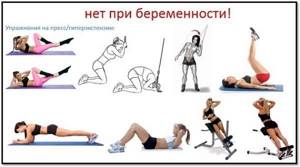Rating: No rating
You will learn how to exercise for pregnant women in the 1st, 2nd and 3rd trimester at home. What are the main differences between physical activity at different times, as well as the main rules that must be followed while in the position. The article also talks about the benefits of light daily exercise for the expectant mother.
What morning exercises can you do during pregnancy?

Exercise for pregnant women is useful. There is no longer any doubt about this, since most doctors support this statement. But you cannot continue to train as you did before your pregnancy began. Such training will harm not only the woman, but also the fetus. The intensity of classes should be reduced.
The following exercises are recommended for morning workouts:
- walking. It will be useful at any stage of pregnancy, even in the later stages;
- exercises with your own weight. You can do squats, steps on a bench, light lunges. The use of additional weights is not recommended; it is better to work with your own weight;
- stretching exercises, for example, “cat”. You can also lie on your back with a cushion underneath. This helps relieve tension from the back;
- swimming and special water aerobics for pregnant women.
Benefits of classes
Gymnastics for pregnant women in the 2nd trimester is very useful. A reasonable approach to activities can improve the overall well-being of the mother and have a positive effect on the child. Moderate physical activity from the 14th week helps prepare the body for the upcoming birth. Although there are still two trimesters ahead, you need to prepare in advance. By the time of childbirth, the woman will become more resilient and her body will become stronger. The expectant mother will learn to control her own body. This will help during labor, because strong muscles are the key to less discomfort and pain during contractions. That is why you should not give up sports if your health allows.
Useful exercises in the 2nd trimester can do a lot. Physical education has a beneficial effect on all organs and systems. Thanks to her:
- the body's protective functions increase;
- the spine and lumbar area are strengthened;
- back pain disappears;
- the cardiovascular system works well;
- blood pressure returns to normal;
- gastrointestinal tract functions improve;
- hemorrhoids are prevented;
- swelling of the lower extremities disappears;
- The process of transporting oxygen to the baby is accelerated.
For pregnant women in the second trimester, physical exercise is simply necessary if rapid weight gain occurs. Excess body weight is an additional burden that the body will have to cope with. Often, excess weight complicates labor. Exercising will help burn unnecessary calories.

Exercises should be performed with extreme caution and under the supervision of a trainer.
Pregnant women who do not forget about activity find it easier to get back into shape after the birth of the baby. Training eliminates the accumulation of fat in problem areas: thighs, buttocks. Exercising early will help avoid stretch marks later on.
Gymnastics will give the expectant mother a boost of energy. Training improves your psycho-emotional state and helps combat mood swings that accompany most pregnant women. If the expectant mother is active, then she will not face prenatal depression.
Basic Rules

Exercises for pregnant women should be carried out in accordance with a number of rules that must be followed. The main ones include:
- Each trimester of pregnancy has its own characteristics. On the first, it is better to refrain from heavy exercises, spend time on breathing exercises, walking, and the lightest movements; on the second, the most active movements are allowed, and on the third, you need to slow down again;
- exercises should be easy, not exhausting;
- It is not recommended to train for too long. It is important to keep the body in good shape, and not strive for muscle development or radical weight loss;
- You should avoid exercises that directly load the abdominal area. Strengthening this area should be done with light movements, and not with lifting the body or twisting;
- Proper, healthy nutrition plays an important role. It should be balanced and optimal in calorie content. Without following this rule, no amount of training will help;
- special attention should be paid to strengthening the back , since during pregnancy the spine receives maximum load.
Morning exercises for pregnant women in the 1st trimester
Exercises for pregnant women in the 1st trimester are based on mastering breathing techniques and the ability to relax. The big belly is not yet visible, so not all young mothers think about the fact that now they need to start avoiding unnecessary stress, because this can cause the threat of termination of pregnancy. Therefore, it is better not to allow intensive training.
To warm up at the beginning of exercises for pregnant women in the 1st trimester, exercises such as cross-walking, bending forward while exhaling - 5-6 times, tilting the body to the right and left, and bending back are perfect. It is recommended to complete the exercises for pregnant women in the first trimester by rotating the feet in a circle and lifting on the tiptoes; these exercises are the prevention of varicose veins and leg cramps.
It takes about twenty minutes every day to do this gymnastics.
Safe and healthy exercises
Some exercises are considered beneficial during pregnancy, while others are best not done at all. The recommended ones include the following:
| Squats | Stand up straight and sit low, rising smoothly. The use of additional weight is prohibited. |
| Side bends | With a straight back, tilt your body to the sides. You can take a large dumbbell, about a couple of kilograms. |
| Cat | Get on all fours and bend your back at the waist, lifting your pelvis and head up. |
| Exercises on a fitball with dumbbells | You can bend your arms into biceps, extend them behind your head into triceps, or lift them up to train your shoulders. In any case, a projectile weighing no more than three kilograms is used. |
| Lumbar stretch | Lie on the floor, place a cushion about 10 centimeters high under your lower back. Lie down for 10 seconds, take a break and repeat. |
| Hand squeezing | Stand up straight or sit on a fitball. Clasp your hands in front of you, pressing one onto the other. This exercise works the pectoral muscles. |
| Pelvic rotation on a fitball | Sit on a special ball, place your hands on your knees or rest your hands on your sides. Rotate your pelvis in each direction alternately. |
| Foot rotations | Sit on a bench, lift one leg and rotate your foot. Helps with blood circulation in the legs, preventing varicose veins. |
| Squeezing a fitball in front of you | Do the same as hand squeezing, only while standing and take a fitball between your hands. |
A mandatory exercise is walking. They will help improve blood circulation, increase muscle tone and speed up metabolism.
Attention! If you experience any unpleasant sensations while performing the exercises, it is strongly recommended to stop doing them, and also consult a doctor, describing your condition to him.

Some movements should never be performed. Pregnant women performing them are at risk, and the consequences can be very serious, including termination of pregnancy. Such movements include:
- squats. Creates a lot of pressure in the abdominal area, which is contraindicated during pregnancy;
- bench press with a barbell;
- deadlift, both with a barbell and dumbbells;
- other heavy exercises with a barbell or heavy dumbbells. It is better to postpone them until the end of pregnancy;
- intense running;
- jumping in place, jumping rope and other types of jumps and other sudden movements;
- hanging leg raises, crunches or other heavy abdominal exercises.
Any exercises that create excessive stress on the abdominal area, as well as on the body as a whole, are not permitted. It is best to exercise lightly, devoting time only to maintaining body tone, and not to increasing athletic performance.
It’s better to completely forget about heavy weights during pregnancy. You shouldn’t work on increasing your muscles, endurance, or strength. The main task of sports in this situation is to maintain muscle tone and improve health.
Contraindications
Physical activity for pregnant women includes simple morning exercises and all kinds of sports poses or exercises. There are also special complexes that correct common pathologies - varicose veins, osteochondrosis, etc. When exercising at home, it is very important to accurately determine the level of physical fitness. exercises and their intensity.
Any gymnastics during the period of bearing a baby must be agreed with a doctor.
The category forbidden for expectant mothers includes all kinds of horse racing, strength exercises, as well as procedures that involve sudden movements.
In order not to harm either yourself or your baby, each workout should proceed at a moderate speed, quite gently and without sudden jerks.

Prohibited gymnastics during pregnancy The number of approaches and repetitions is proportional to the level of personal physical fitness. preparation. In general, the duration of the sports complex cannot be more than 40 minutes. It is correct to divide the workout into ten-minute intervals, alternating with pauses.
Expert advice

Most professionals believe that exercise during pregnancy will bring positive results if it is easy and relaxed. Pregnant women should not exhaust themselves with heavy exercises, as they can cause negative consequences, but they should not completely abandon physical education either.
To begin with, it is better to consult a doctor. Only he can determine the woman’s condition and whether she has complications. If the pregnancy is going well, then physical exercise will only bring benefits; if there are difficulties, then the issue is resolved individually, depending on the specific problems.
Professionals also point out that, in addition to sports, you need to follow a number of recommendations. First of all, this concerns proper nutrition, which must be balanced and contain the correct balance of nutrients. You should not give in to the desire to eat everything, this can cause negative consequences.
Experts, including doctors and sports trainers, also believe that heavy exercise should be avoided. During pregnancy, you need to take care of your health, and not about achieving any sports results.
Water gymnastics or aqua aerobics for expectant mothers
Water gymnastics has taken a leading place among the popular types of gymnastics. This is so because for most pregnant women, exercise in water is much easier, due to the body acquiring a weightless state. And water itself is a good sedative, which a woman so needs throughout the entire period of pregnancy. In addition, according to many doctors, this is the safest form of gymnastics. A woman will be able to do water aerobics from the beginning of the second trimester of pregnancy, and continue training until the 39th week. Sometimes doctors prescribe aerobics in the pool as a mandatory procedure for greatly increased body weight, since water aerobics is the best type of gymnastics for weight loss.











